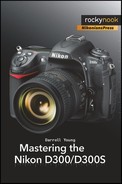Book Description
Mastering the Nikon D300/D300S, by Darrell Young, provides a wealth of experience-based information and insights for owners of these powerful and sophisticated cameras. Darrell is determined to help the user navigate past the confusion factor that often comes with complex but powerful new professional camera equipment.
The book explores the features and capabilities of the two cameras in a way that completely surpasses user's manuals. It guides readers through the DSLR camera features with step-by-step setting adjustments, color illustrations, and detailed explanations for each option. Each button, dial, switch, screen, and menu configuration option is explored in a user-friendly manner, with suggestions for setup according to various shooting styles.
Darrell Young's friendly and informative writing style allows readers to easily follow directions, while feeling as if a friend dropped in to share his knowledge. The learning experience for D300/D300S beginners-and refresher information for professionals-goes beyond just the camera itself. Detailed explanations cover White Balance, the Histogram, the Multi-CAM 3500DX autofocus system, and how the Live View and D-Movie modes work. Camera accessories such as Speedlight flash and GPS units are also considered.
Table of Contents
- Mastering the Nikon D300/D300S
- Dedication
- Foreword
- Camera Body Reference
- Colors and Wording Legend
- Special D300 Information
- 1. Basic Camera Setup
- 2. Playback Menu
- 3. Shooting Menu
- Shooting Menu Bank
- Reset Shooting Menu
- Active Folder
- File Naming
- Primary Slot Selection (D300S Only)
- Secondary Slot Function (D300S Only)
- Image Quality
- Image Size
- JPEG Compression
- NEF (RAW) Recording
- White Balance
- Set Picture Control
- Manage Picture Control
- Color Space
- Active D-Lighting
- Long Exp. NR
- High ISO NR
- ISO Sensitivity Settings
- Live View Mode
- Multiple Exposure
- Movie Settings (D300S Only)
- Interval Timer Shooting
- My Conclusions
- 4. Custom Setting Menu
- Renaming a Custom Setting Bank
- Reset Custom Settings
- Section One – (a) Autofocus: Custom Settings a1 to a10
- Section Two – (b) Metering/Exposure: Custom Settings b1 to b6
- Section Three – (c) Timers/AE Lock: Custom Settings c1 to c4
- Section Four – (d) Shooting/Display: Custom Settings d1 to d12
- Section Five – (e) Bracketing/Flash: Custom Settings e1 to e7
- Section Six – (f) Controls: Custom Settings f1 to f11
- Switch (Backlight)
- Multi Selector Center Button
- Multi Selector
- Photo Info/Playback
- Assign Fn (FUNC.) Button – Custom Setting f5 (D300S) and f4 (D300)
- Assign Preview Button – Custom Setting f6 (D300S) and f5 (D300)
- Assign AE-L/AF- L Button – Custom Setting f7 (D300S) and f6 (D300)
- Customize Command Dials
- Release Button to Use Dial
- No Memory Card?
- Reverse Indicators
- My Conclusions
- 5. Setup Menu
- Format Memory Card
- LCD Brightness
- Clean Image Sensor
- Lock Mirror Up For Cleaning
- Video Mode
- HDMI
- Time Zone and Date or World Time
- Language
- Image Comment
- Auto Image Rotation
- USB (D300 only)
- Image Dust Off Ref Photo
- Battery Info
- Wireless Transmitter
- Image Authentication
- Copyright Information (D300S Only)
- Save/Load Settings
- GPS
- Virtual Horizon (D300S only)
- Non-CPU Lens Data
- AF Fine Tune
- Eye-Fi Upload (D300S only)
- Firmware Version
- My Conclusions
- 6. Retouch Menu
- 7. My Menu and Recent Settings
- 8. Live View and D-Movie Modes
- 9. Metering, Exposure Modes, and Histogram
- 10. White Balance
- How Does White Balance (WB) Work?
- Color Temperature
- Method 1 – Manual White Balance Using the WB Button
- Manually Selecting a Color Temperature between 2,500 and 10,000 K
- Measuring Actual Ambient Light and Using PRE
- Storing White Balance Values for Future Use
- Editing the Comment Field
- Using the White Balance from a Previously Captured Image
- Adjusting a Saved White Balance’s Color Values
- Method 2 – Manual White Balance Using the Shooting Menu
- White Balance Bracketing
- Auto White Balance
- White Balance Tips and Tricks
- My Conclusions
- 11. Multi-CAM 3500DX Autofocus
- 12. Speedlight Flash Photography
- Credits for Chapter Opening Images
- Nikonians Gold Membership
- Additional Downloadable Resources Website
- Index
- About the Author
- Copyright
